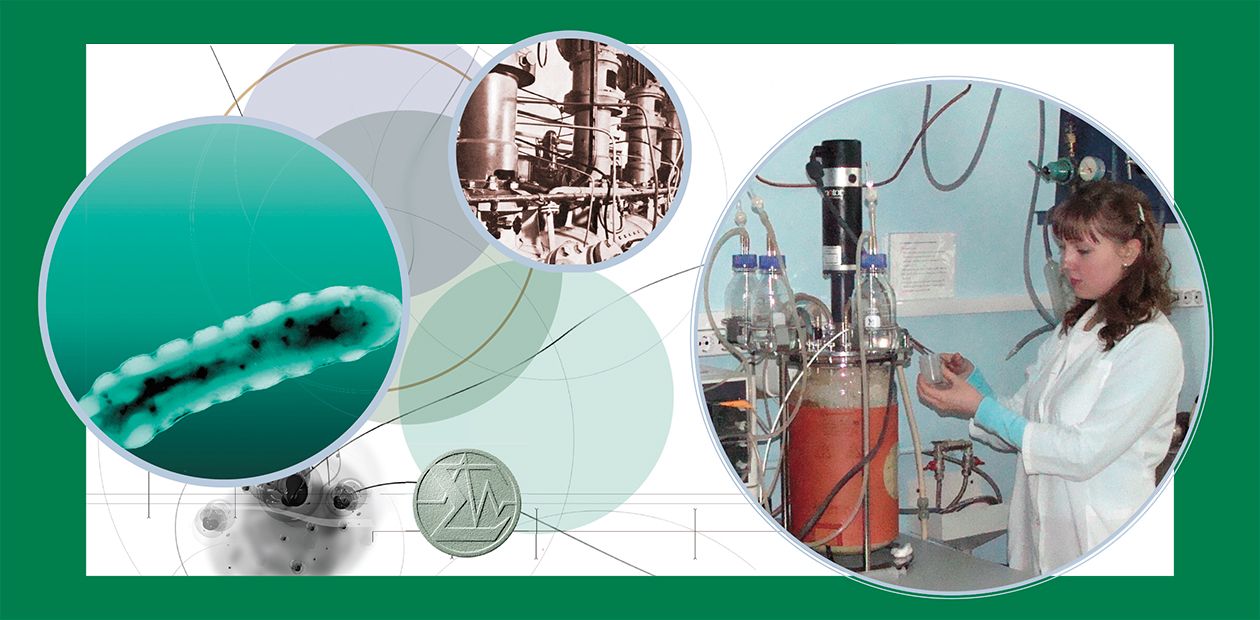Hydrogen-Based Biotechnologies
Researchers of the Institute of Biophysics SB RAS (Krasnoyarsk) have developed unique technologies of manufacturing products with predetermined properties, using hydrogen-reducing microorganisms. Synthesis of single cell protein and degradable bioplastics has been carried out at pilot production facilities
Biotechnologies based on using the potential of living systems are capable of solving major problems of life support: production of food, mineral materials, and energy resources; creation of new materials and of diagnostic and treatment tools; recycling of toxic wastes; etc.
Of particular interest are hydrogen bacteria, which synthesize hundreds of various organic compounds from carbon dioxide, using the energy released during the course of the hydrogen oxidation reaction.
Chemoautotrophy as a new mode of life was discovered by S. N. Vinogradsky, an outstanding Russian scientist. Practical interest in such microorganisms arose in the 1970s: they recommended as a tool for revitalization in closed life support systems intended for space flights. In Russia, studies of hydrogen-oxidizing bacteria were initiated by Academician G. A. Zavarzin at the Vinogradsky Institute of Microbiology RAS (Moscow), where representatives of this most interesting group of microorganisms were isolated, identified, and described.
The proposal of cooperation between Moscow microbiologists and Krasnoyarsk biophysicists came from Academician I. I. Gitelson. In January 1968, G. A. Zavarzin visited Krasnoyarsk and brought samples of bacterial cultures. This was the beginning of hydrogen biosynthesis studies at the Institute of Biophysics SB RAS.
Over a relatively short period of time, the researchers of the Institute designed a series of laboratory installations for bacteria cultivation and managed to maintain and study a steady-state continuous culture. A large body of experimental data was gathered on kinetics and physiology of bacterial growth; changes in their metabolism were examined as influenced by various factors.
In the 1980s, these studies provided a basis for establishing a pilot facility for the production of a new animal food – biomass of hydrogen bacteria (BHB). Numerous zootechnical, veterinary, biomedical, and toxicological experiments on farm and fur-bearing animals showed that the food could be successfully used as a source of protein.
Once the decision to establish the pilot facility for the production of BHB had been made, the research team began large-scale studies aimed at finding new substrates in order to reduce the cost of the product. Bacterial strains resistant to carbon monoxide were examined as potential producers. As a result, the Institute of Biophysics in collaboration with the Ukrainian Institute of Gas and the Institute of Chemistry and Chemical Technology SB RAS, developed processes of BHB synthesis using converted gas and products of gasification of low-grade brown coals.
Krasnoyarsk researchers have also developed another technology involving the use of hydrogen bacteria: synthesis of degradable high-molecular-weight polymers, which must replace synthetic plastics in the future. It is only quite recently that the group of well-studied biodegradable compounds that are already being used has been joined by polyhydroxyalkanoates (PHAs) – a class of natural macromolecules synthesized by bacteria, using a variety of substrates. PHAs are a biological analog of polyolefins – synthetic polymers produced from hydrocarbons, polyethylene being their best-known representative.
Hydrogen bacteria were found to be able to produce, under certain conditions, large amounts of PHA (up to 90 % of the mass of cell substance) and, what is more, to synthesize polymers with different chemical structures. Researchers of the IBP SB RAS developed technologies of synthesizing polymers with different chemical structures based not only on hydrogen but also on sugars, plant hydrolyzates, and acetate. The work has gone beyond the scope of laboratory research: the Institute of Biophysics, in cooperation with the Biokhimmash Research Institute (Moscow), established a pilot facility for the production of a biotechnological product trademarked BIOPLASTOTAN.
However, to make a new material was only part of the job, followed by processing the polymers into specialized items in the form of monofilaments, flexible films, microparticles, and three-dimensional constructions, using various techniques. The PHA-based items were found to work effectively as implants, sutures, bone replacements, and scaffolds for targeted drug delivery in the body. At present a series of experimental BIOPLASTOTAN specimens intended for biomedical uses are being clinically tested.
However, medicine is not the only sphere where biodegradable bacterial polymers can be of use. Bioplastotan can serve as a scaffold for storage and targeted delivery of fertilizers and weed and pest killers, thus reducing the application of these environmentally hazardous substances and preventing their accumulation in the biosphere.
The team of researchers is now engaged in another important task, namely in examining the degradation of PHA items in natural conditions. Degradation rates of BIOPLASTOTAN-based items have been determined for soils, freshwater and saltwater, and for tropical environments. Obviously, packaging made of biodegradable plastics is still unaffordable. However, human industrial activities endanger the very existence of the human race on our planet. Therefore, adoption of new, environmentally safe, technologies is a way to harmonize the relationship between human society and nature.
References
Volova T. G., Sevastianov V. I., Shishatskaya E. I. Polioxialkanoaty – biorazrushaemyye polimery dlya meditsiny (Polyhydroxyalkanoates – biodegradable polymers for medicine). Novosibirsk: Nauka, 2003; Krasnoyarsk: Platina, 2006 [in Russian].
T. G. Volova Promising plastic for medicine. // SCIENCE First Hand # 1(22), 2009. P. 20—21.







